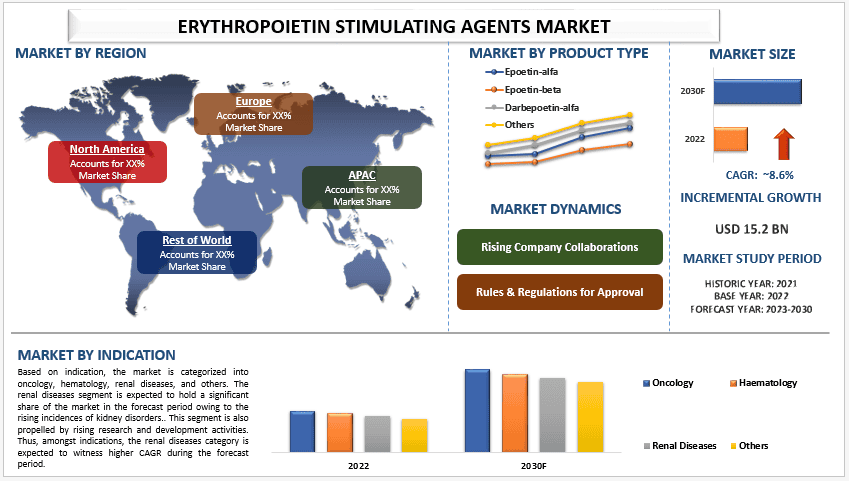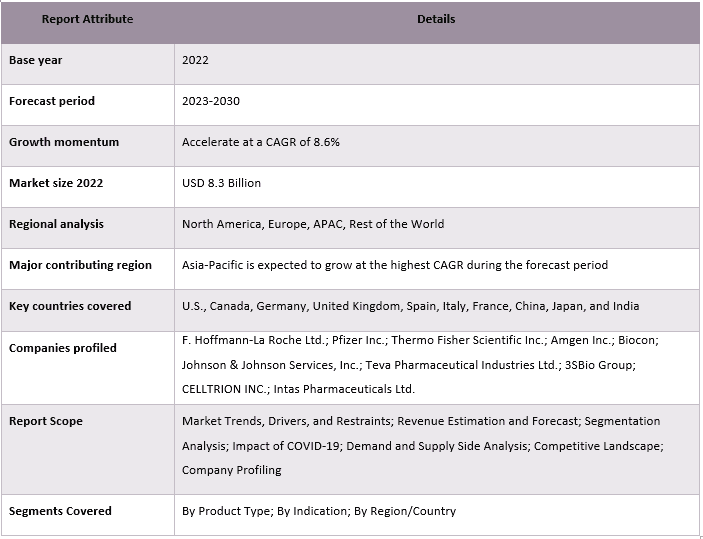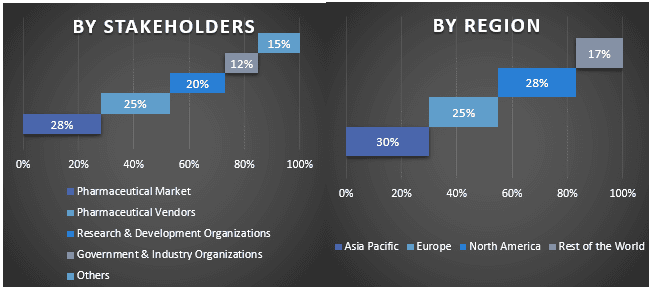- Home
- About Us
- Industry
- Services
- Reading
- Contact Us
Erythropoietin Stimulating Agents Market: Current Analysis and Forecast (2023-2030)
Emphasis on Product Type (Epoetin-alfa, Epoetin-beta, Darbepoetin-alfa, and Others); Indication (Oncology, Hematology, Renal Diseases, and Others); and Region/Country

The Global Erythropoietin Stimulating Agent Market was valued at USD 8.3 Billion in 2022 and is expected to grow a CAGR of 8.6% during the forecast period (2023-2030). Erythropoietin stimulating agents (ESAs) are drugs that boost red blood cell production, commonly used to address anemia in conditions like chronic kidney disease or cancer. They work similarly to the natural hormone erythropoietin, stimulating red blood cell formation in the bone marrow. However, their usage needs careful monitoring due to potential side effects like increased risk of blood clots or elevated blood pressure. Erythropoietin stimulating agents are mainly used in cases of acute blood deficiency or anemia which might occur due to several chronic conditions including kidney disorder, cancer, and others. Also, anemia is mainly gaining prominence due to the increased consumption of alcohol and tobacco. According to the University of Texas’s MD Anderson Cancer Center, anemia is a common condition in cancer patients.
- Hoffmann-La Roche Ltd.; Pfizer Inc.; Thermo Fisher Scientific Inc.; Amgen Inc.; Biocon; Johnson & Johnson Services, Inc.; Teva Pharmaceutical Industries Ltd.; 3SBio Group; CELLTRION INC.; Intas Pharmaceuticals Ltd. are some of the key players in the market. Several M&As along with partnerships have been undertaken by these players to facilitate customers with hi-tech and innovative products/technologies.
Insights Presented in the Report
“Amongst product type, darbepoetin-alfa category to witness higher CAGR during the forecast period”
Based on product type, the market is segmented into epoetin-alfa, epoetin-beta, darbepoetin-alfa, and others. The darbepoetin-alfa segment is expected to grow with a high CAGR during the forecast period as it has a longer half-life in the human body, allowing for less frequent dosing compared to some other medications. It’s a synthetic form of erythropoietin, a hormone that stimulates the production of red blood cells in the bone marrow which is used to treat anemia, particularly in patients with chronic kidney disease or those undergoing chemotherapy. A diet lacking in fruits and vegetables, an increasing geriatric population, and a rising number of anemic patients are boosting its growth in the market. For instance, according to the Institute for Health Metrics and Evaluation in July 2023, one-fourth of the global population is estimated to be anemic in the coming years, with cases increasing rapidly for women, expectant mothers, young girls, and children younger than age 5. Thus, the darbepoetin-alfa category is expected to witness a higher CAGR during the forecast period.
“Amongst indication, oncology held a significant share in the market in 2022”
Based on indication, the market is categorized into oncology, hematology, renal diseases, and others. The bioinformatics segment is dominating the market owing to the rising cases of cancer globally. For instance, according to the World Cancer Research Fund International, there were more than 1.4 million new cases of prostate cancer in 2020. Oncology-related anemia refers to a condition where a person diagnosed with cancer experiences a lower-than-normal level of red blood cells due to the cancer itself or its treatments. It’s a prevalent complication in cancer patients, affecting both the quality of life and the overall management of the disease. Thus, oncology held a significant share of the market in 2022.
“Amongst regions, APAC is expected to witness a higher CAGR during the forecast period”
APAC is expected to grow with a high CAGR in the global erythropoietin stimulating agent market in the forecast period. Several factors such as a surge in the development of a wide range of therapeutics for anemia treatment, enhanced accessibility, and diversified healthcare costs are driving the market’s growth during the forecast period. Further, the increase in incidences of chronic diseases of the kidney and cancer are also having a positive impact on the market’s growth. There have been significant improvisations and enhancements in erythropoietin-stimulating agents in the region. For instance, according to the National Institute of Health in 2022, there were approximately 4,820,000 and 2,370,000 new cancer cases in China. Thus, APAC is expected to witness a higher CAGR during the forecast period.
Erythropoietin Stimulating Agent Market Report Coverage

Reasons to buy this report:
- The study includes market sizing and forecasting analysis validated by authenticated key industry experts.
- The report presents a quick review of overall industry performance at one glance.
- The report covers an in-depth analysis of prominent industry peers with a primary focus on key business financials, product portfolio, expansion strategies, and recent developments.
- Detailed examination of drivers, restraints, key trends, and opportunities prevailing in the industry.
- The study comprehensively covers the market across different segments.
- Deep dive regional level analysis of the industry.
Customization Options:
The global erythropoietin stimulating agent market can further be customized as per the requirement or any other market segment. Besides this, UMI understands that you may have your own business needs, hence feel free to contact us to get a report that completely suits your requirements.
Table of Content
Research Methodology for the Erythropoietin Stimulating Agents Market Analysis (2023-2030)
Analyzing the historical market, estimating the current market, and forecasting the future market of the global erythropoietin stimulating agent market were the three major steps undertaken to create and analyze the adoption of erythropoietin stimulating agents in major regions globally. Exhaustive secondary research was conducted to collect the historical market numbers and estimate the current market size. Secondly, to validate these insights, numerous findings and assumptions were taken into consideration. Moreover, exhaustive primary interviews were also conducted, with industry experts across the value chain of the global erythropoietin stimulating agent market. Post assumption and validation of market numbers through primary interviews, we employed a top-down/bottom-up approach to forecasting the complete market size. Thereafter, market breakdown and data triangulation methods were adopted to estimate and analyze the market size of segments and sub-segments of the industry pertains to. Detailed methodology is explained below:
Analysis of Historical Market Size
Step 1: In-Depth Study of Secondary Sources:
Detail secondary study was conducted to obtain the historical market size of the erythropoietin stimulating agent market through company internal sources such as annual reports & financial statements, performance presentations, press releases, etc., and external sources including journals, news & articles, government publications, competitor publications, sector reports, third-party database, and other credible publications.
Step 2: Market Segmentation:
After obtaining the historical market size of the erythropoietin stimulating agent market, we conducted a detailed secondary analysis to gather historical market insights and share for different segments & sub-segments for major regions. Major segments are included in the report as product type, indication, and regions. Further country-level analyses were conducted to evaluate the overall adoption of testing models in that region.
Step 3: Factor Analysis:
After acquiring the historical market size of different segments and sub-segments, we conducted a detailed factor analysis to estimate the current market size of the erythropoietin stimulating agent market. Further, we conducted factor analysis using dependent and independent variables such as product type, indication, and regions of erythropoietin stimulating agents. A thorough analysis was conducted for demand and supply-side scenarios considering top partnerships, mergers and acquisitions, business expansion, and product launches in the erythropoietin stimulating agent market sector across the globe.
Current Market Size Estimate & Forecast
Current Market Sizing: Based on actionable insights from the above 3 steps, we arrived at the current market size, key players in the global erythropoietin stimulating agent market, and market shares of the segments. All the required percentage shares split, and market breakdowns were determined using the above-mentioned secondary approach and were verified through primary interviews.
Estimation & Forecasting: For market estimation and forecast, weights were assigned to different factors including drivers & trends, restraints, and opportunities available for the stakeholders. After analyzing these factors, relevant forecasting techniques i.e., the top-down/bottom-up approach were applied to arrive at the market forecast for 2030 for different segments and sub-segments across the major markets globally. The research methodology adopted to estimate the market size encompasses:
- The industry’s market size, in terms of revenue (USD) and the adoption rate of the erythropoietin stimulating agent market across the major markets domestically
- All percentage shares, splits, and breakdowns of market segments and sub-segments
- Key players in the global erythropoietin stimulating agent market in terms of products offered. Also, the growth strategies adopted by these players to compete in the fast-growing market
Market Size and Share Validation
Primary Research: In-depth interviews were conducted with the Key Opinion Leaders (KOLs) including Top Level Executives (CXO/VPs, Sales Head, Marketing Head, Operational Head, Regional Head, Country Head, etc.) across major regions. Primary research findings were then summarized, and statistical analysis was performed to prove the stated hypothesis. Inputs from primary research were consolidated with secondary findings, hence turning information into actionable insights.
Split of Primary Participants in Different Regions

Market Engineering
The data triangulation technique was employed to complete the overall market estimation and to arrive at precise statistical numbers for each segment and sub-segment of the global erythropoietin stimulating agent market. Data was split into several segments & sub-segments post studying various parameters and trends in the areas of product type, indication, and regions in the global erythropoietin stimulating agent market.
The main objective of the Global Erythropoietin Stimulating Agents Market Study
The current & future market trends of the global erythropoietin stimulating agent market were pinpointed in the study. Investors can gain strategic insights to base their discretion for investments on the qualitative and quantitative analysis performed in the study. Current and future market trends determined the overall attractiveness of the market at a regional level, providing a platform for the industrial participant to exploit the untapped market to benefit from a first-mover advantage. Other quantitative goals of the studies include:
- Analyze the current and forecast market size of the erythropoietin stimulating agent market in terms of value (USD). Also, analyze the current and forecast market size of different segments and sub-segments
- Segments in the study include areas of product type, indication, and regions
- Define and analyze the regulatory framework for the erythropoietin stimulating agent industry.
- Analyze the value chain involved with the presence of various intermediaries, along with analyzing customer and competitor behaviors of the industry.
- Analyze the current and forecast market size of the erythropoietin stimulating agent market for the major region.
- Major countries of regions studied in the report include Asia Pacific, Europe, North America, and the Rest of the World.
- Company profiles of the erythropoietin stimulating agent market and the growth strategies adopted by the market players to sustain in the fast-growing market
- Deep dive regional level analysis of the industry
Frequently Asked Questions FAQs
Q1: What is the current market size and growth potential of the erythropoietin stimulating agent market?
Q2: What are the driving factors for the growth of the erythropoietin stimulating agent market?
Q3: Which segment has the largest share of the erythropoietin-stimulating agent market by product type?
Q4: What are the emerging technologies and trends in the erythropoietin stimulating agent market?
Q5: Which region will dominate the erythropoietin-stimulating agent market?
Q6: Who are the key players operating in the erythropoietin-stimulating agent market?
Related Reports
Customers who bought this item also bought










